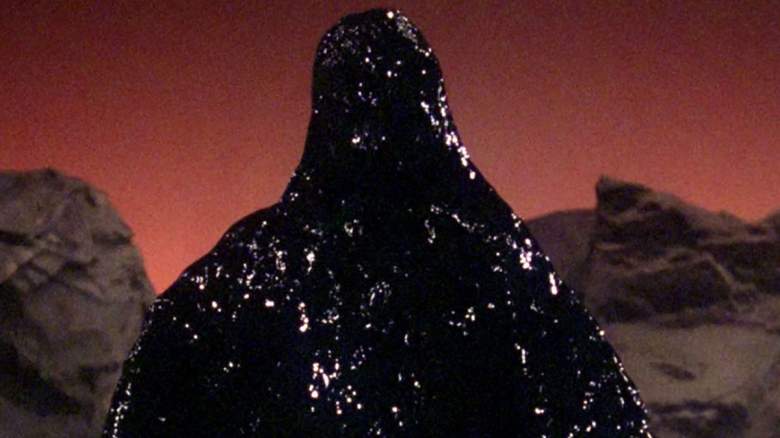
CBS Mart McChesney as Armus.
When counting the various species of alien which fans have seen on “Star Trek,” most of them have a few things in common. Most Trek aliens have two eyes, two ears, a nose, a mouth, two legs, two arms… in essence, they are a lot like us. They almost always speak perfect English — universal translator or not — with just a few exceptions.
In fact, some say that they are just “one facial feature away from humanity.” TV Tropes calls these “rubber forehead aliens” and cites “Star Trek” as the franchise most guilty of this tendency. Many fans are okay with this, as becoming an “alien” is as easy as creating a rubber mold and adding a little paint.
Sometimes “Star Trek” even skipped the forehead rubber and just went for a few ridges on the nose, as in the case of the Bajorans. Those folks are among the least exotic species ever featured on the series.
Low Budget Aliens
There are perfectly good explanations for why Trek didn’t go all out on their alien species, like “Star Wars” did. The first was money, as “The Original Series” had very little to go around for extras. According to Memory Alpha, Gene Roddenberry had $190,635 per episode to make “Star Trek” for Season One. Each season got fewer dollars to use, with just $175,000 per episode for Season Three.
Roddenberry often found that creating exotic aliens was just too expensive. The very first Trek villains, the Telosians, were supposed to be crab-like, not giant-brained humans. Thanks to a report by CBR, this plan was canceled because of the cost and the fact that the crabs would be “unconvincing and harken back to cheap 1950s monster movies.”
Chariot of the Trek Gods
Because of these budgetary limitations, Trek would stick with the human-like form for most of their species. These are referred to as “Humanoids.” In fact, a “Next Generation” episode explained why this was. “The Chase” revealed that a species long dead had sprinkled its genetic design over hundreds of thousands of worlds. This idea is called “Panspermia,” and StarTrek.com has a great article explaining how all of this is plausible.
In “The Chase,” Picard, Dr. Crusher, Worf, some Romulans, Cardassians, and a Klingon triggered an ancient hologram from this dead race, explaining everything. “The Chase” was inspired by the theories of astrophysicist Carl Sagan. Sagan famously said that the “evolutionary record is very clear that extraterrestrials would be very different from us.”
Unique Trek Species
So the fact that “Star Trek” does have some non-humanoid species is quite exceptional. They are few, but they are remarkable. Among them are the Crystalline Entity, the Sheliak, the Edosian, the Founders, and Species 8472.
Beyond those creatures was one that proved to be both a menace and evil. The Armus creature, known to most Trek fans as the “pool of oil which killed Tasha Yar,” is unique in the series. According to Den of Geek, the creature was “coagulated goo made out of negative emotions.” He was a member of the Vagran race, which a “race of Titans.” Armus was so evil that he became a living sludge, and he was the subject of the Season One episode “Skin of Evil.”
Eventually, Picard (Patrick Stewart), Data (Brent Spiner), and the others figured out a way to escape from the creature. Unfortunately, their victory came at a significant cost — the death of Lt. Tasha Yar (Denise Crosby).
Armus was Made From Metamucil and Printer Ink
While the Armus made for great TV, what exactly was he made of? How did the costume work? His haunting voice was provided by actor Ron Gans, and the goo itself was “made from Metamucil and black printers’ ink,” according to Memory Alpha. The episode itself was written by Joseph Stefano and Hannah Louise Shearer. Stefano is most famous for writing the screenplay for Alfred Hitchcock’s “Psycho.”
Memory Alpha also detailed that just one actor (Mart McChesney) inside the Armus costume and required frequent breaks, as there was no oxygen supply. The head of the outfit was sold for just $1,800 at auction in 2006.
Jonathan Frakes Actually Did Plunge Into ‘Armus’
In the episode, Commander Will Riker (Frakes) is pulled into the Armus pit by some unknown power. This was not a stunt double, but the actor himself. Frakes said he was “naive and eager” when he agreed to jump into the pit.
On the Blu-ray special features for “Star Trek: The Next Generation” Season One, Frakes shared something that he’ll never forget:
“One of my favorite moments in ‘Star Trek’ took place just after I was vomited up onto the beach covered with Metamucil and black printer’s ink… LeVar Burton comes over as Geordi and leans over me… he says, ‘Oh, Frakes, I would never have done that!’”
The Return of Armus
Armus returned for a comedy cameo for “Star Trek: Lower Decks” episode, “The Spy Humongous.”